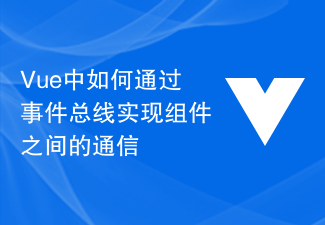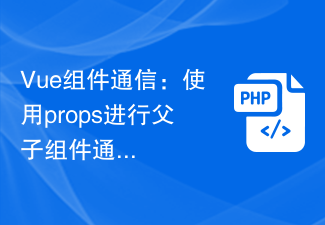
Vue组件通信方式及其实践
在Vue的开发中,组件通信是一个非常重要的概念。它可以让我们将一个复杂的应用拆分成多个独立的组件,使得组件之间的交互更加灵活和高效。Vue提供了多种组件通信的方式,我们可以根据实际需求选择合适的方式来进行组件间的数据传递和交互。本文将介绍Vue组件通信的几种常用方式,并给出相应的代码示例。
一、Props and Events
Props and Events是Vue中最基础和常用的组件通信方式。通过Props,父组件可以向子组件传递数据;而通过Events,子组件可以向父组件发送消息。
- Props传递数据
父组件通过props属性向子组件传递数据,子组件通过props选项接收数据。
代码示例:
// 父组件
<template>
<div>
<child-component :message="parentMessage"></child-component>
</div>
</template>
<script>
import ChildComponent from './ChildComponent.vue'
export default {
components: {
ChildComponent
},
data() {
return {
parentMessage: 'Hello from parent component!'
}
}
}
</script>
// 子组件
<template>
<div>{{ message }}</div>
</template>
<script>
export default {
props: {
message: String
}
}
</script>在这个例子中,父组件通过:message="parentMessage"将parentMessage传递给子组件,并通过props定义了子组件接收的数据类型。:message="parentMessage"将parentMessage传递给子组件,并通过props定义了子组件接收的数据类型。
- Events发送消息
子组件通过$emit方法向父组件发送消息。父组件通过在子组件标签上添加事件监听来接收消息。
代码示例:
// 父组件
<template>
<div>
<child-component @message="handleMessage"></child-component>
</div>
</template>
<script>
import ChildComponent from './ChildComponent.vue'
export default {
components: {
ChildComponent
},
methods: {
handleMessage(message) {
console.log(message)
}
}
}
</script>
// 子组件
<template>
<button @click="sendMessage">Send Message</button>
</template>
<script>
export default {
methods: {
sendMessage() {
this.$emit('message', 'Hello from child component!')
}
}
}
</script>在这个例子中,子组件通过this.$emit('message', 'Hello from child component!')发送消息,父组件通过@message监听子组件的消息,并在handleMessage方法中处理。
二、Vuex
Vuex是Vue的官方状态管理库,它提供了一种集中化管理应用状态的方式,用于解决组件间共享数据的问题。
以下是使用Vuex进行组件通信的基本步骤:
- 创建一个Vuex的store对象。
- 在store对象中定义state,即应用的状态。
- 使用getters定义一些派生状态,用于获取和计算state的值。
- 使用mutations定义一些同步操作,用于修改state的值。
- 使用actions定义一些异步操作,用于处理一些复杂的业务逻辑。
- 在组件中使用
this.$store.state获取state的值。
代码示例:
以下是一个简单的Vuex应用的示例。假设我们的应用有一个计数器,通过点击按钮增加计数器的值,并在组件中显示。
// store.js
import Vue from 'vue'
import Vuex from 'vuex'
Vue.use(Vuex)
export default new Vuex.Store({
state: {
count: 0
},
mutations: {
increment(state) {
state.count++
}
},
actions: {
incrementCount({ commit }) {
commit('increment')
}
}
})// Counter.vue
<template>
<div>
<p>Count: {{ count }}</p>
<button @click="incrementCount">Increment</button>
</div>
</template>
<script>
export default {
computed: {
count() {
return this.$store.state.count
}
},
methods: {
incrementCount() {
this.$store.dispatch('incrementCount')
}
}
}
</script>在这个例子中,我们定义了一个名为count的state和一个名为increment的mutation。在组件中,我们使用this.$store.state.count获取count的值,并在点击按钮时通过this.$store.dispatch('incrementCount')调用incrementCount action。
三、Event Bus
Event Bus是一种简单但强大的组件通信方式,它利用Vue的实例作为中央事件总线。我们可以在任意组件上监听自定义事件,并在其他组件上触发相应事件。
以下是使用Event Bus进行组件通信的基本步骤:
- 创建Event Bus实例:
const bus = new Vue() - 在监听事件的组件中使用
bus.$on方法监听自定义事件。 - 在触发事件的组件中使用
bus.$emit方法触发自定义事件。
代码示例:
// Counter.vue
<template>
<div>
<p>Count: {{ count }}</p>
<button @click="incrementCount">Increment</button>
</div>
</template>
<script>
export default {
data() {
return {
count: 0
}
},
methods: {
incrementCount() {
this.count++
this.$bus.$emit('count-updated', this.count)
}
},
created() {
this.$bus.$on('count-updated', (count) => {
this.count = count
})
}
}
</script>
// main.js
import Vue from 'vue'
Vue.prototype.$bus = new Vue()
new Vue({
render: h => h(App),
}).$mount('#app')在这个例子中,我们在Counter组件中创建了一个名为count的数据,并通过点击按钮递增count的值。在递增count的同时,我们使用this.$bus.$emit('count-updated', this.count)触发count-updated事件。在Counter组件的created钩子函数中,我们使用this.$bus.$on
- Events发送消息
子组件通过$emit方法向父组件发送消息。父组件通过在子组件标签上添加事件监听来接收消息。
this.$emit('message', 'Hello from child component!')发送消息,父组件通过@message监听子组件的消息,并在handleMessage方法中处理。🎜🎜二、Vuex🎜Vuex是Vue的官方状态管理库,它提供了一种集中化管理应用状态的方式,用于解决组件间共享数据的问题。🎜🎜以下是使用Vuex进行组件通信的基本步骤:🎜🎜🎜创建一个Vuex的store对象。🎜🎜在store对象中定义state,即应用的状态。🎜🎜使用getters定义一些派生状态,用于获取和计算state的值。🎜🎜使用mutations定义一些同步操作,用于修改state的值。🎜🎜使用actions定义一些异步操作,用于处理一些复杂的业务逻辑。🎜🎜在组件中使用this.$store.state获取state的值。🎜🎜🎜代码示例:🎜以下是一个简单的Vuex应用的示例。假设我们的应用有一个计数器,通过点击按钮增加计数器的值,并在组件中显示。🎜rrreeerrreee🎜在这个例子中,我们定义了一个名为count的state和一个名为increment的mutation。在组件中,我们使用this.$store.state.count获取count的值,并在点击按钮时通过this.$store.dispatch('incrementCount')调用incrementCount action。🎜🎜三、Event Bus🎜Event Bus是一种简单但强大的组件通信方式,它利用Vue的实例作为中央事件总线。我们可以在任意组件上监听自定义事件,并在其他组件上触发相应事件。🎜🎜以下是使用Event Bus进行组件通信的基本步骤:🎜🎜🎜创建Event Bus实例:const bus = new Vue()🎜🎜在监听事件的组件中使用bus.$on方法监听自定义事件。🎜🎜在触发事件的组件中使用bus.$emit方法触发自定义事件。🎜🎜🎜代码示例:🎜rrreee🎜在这个例子中,我们在Counter组件中创建了一个名为count的数据,并通过点击按钮递增count的值。在递增count的同时,我们使用this.$bus.$emit('count-updated', this.count)触发count-updated事件。在Counter组件的created钩子函数中,我们使用this.$bus.$on方法监听count-updated事件,并在回调函数中更新count的值。🎜🎜总结: 🎜本文介绍了Vue中几种常用的组件通信方式,并给出了相应的代码示例。Props and Events是最基础且常用的组件通信方式,适用于父子组件之间的数据传递和消息发送。Vuex是用于管理应用状态的状态管理库,适用于多个组件之间共享状态的情况。Event Bus是一种简单但强大的组件通信方式,可以实现任意组件之间的消息传递。根据实际需求,我们可以选择合适的组件通信方式,来满足不同组件之间的交互需求。同时,更多复杂的场景可能需要使用其他高级的组件通信方式,如provide/inject等。在实际的开发过程中,我们可以根据具体需求灵活使用这些组件通信方式,以实现更高效、灵活的组件交互。🎜以上是Vue组件通信方式及其实践的详细内容。更多信息请关注PHP中文网其他相关文章!
 vue3中怎么使用props和emits并指定其类型与默认值May 19, 2023 pm 05:21 PM
vue3中怎么使用props和emits并指定其类型与默认值May 19, 2023 pm 05:21 PMdefineProps的使用defineProps在使用的时候无需引入,默认是全局方法。在js开发的vue3项目中使用constprops=defineProps({attr1:{type:String,//S必须大写default:"",},attr2:Boolean,attr3:{type:Number,required:true,},});js环境中使用与vue2的使用方法类似,只是选项式API换成了组合式API。定义props类型与默认值都与vue2类型,vue3中使
 Vue3中props和emit怎么使用May 26, 2023 pm 06:13 PM
Vue3中props和emit怎么使用May 26, 2023 pm 06:13 PM作用:父组件通过props向下传递数据给子组件;用途:当有一种类型的组件需要被使用多次,每一次的调用都只是特定的地方不同,就好像一张个人简介表,每次填的人的信息都不同,但是结构都是一样的。用法1(不指定类型的简单接受):在父组件里面引入子组件,通过子组件的标签属性传递参数,在子组件里面定义一个props选项进行接收使用,要注意在子组件里面不需要在props以外的地方事先定义在上面可以看见传进来的age是一个字符串类型,如果想要让传进来的值自动加1不能在子组件使用时里面+1,如下图所示会变成字符串
 如何解决Vue报错:无法使用props传递数据Aug 17, 2023 am 10:06 AM
如何解决Vue报错:无法使用props传递数据Aug 17, 2023 am 10:06 AM如何解决Vue报错:无法使用props传递数据前言:在Vue的开发过程中,使用props来进行父子组件之间的数据传递是非常常见的。然而,有时候我们可能会遇到一个问题,即在使用props传递数据时,会出现报错的情况。本文将重点介绍如何解决Vue中无法使用props传递数据的报错。问题描述:在Vue开发中,当我们在父组件中使用props来传递数据给子组件时,如果
 Vue中如何通过事件总线实现组件之间的通信Oct 15, 2023 am 08:30 AM
Vue中如何通过事件总线实现组件之间的通信Oct 15, 2023 am 08:30 AMVue中如何通过事件总线实现组件之间的通信,需要具体代码示例事件总线是Vue中一种常见的组件通信机制,它允许不同组件之间进行简洁、灵活的通信,而无需显式地引入父子组件关系或使用Vuex等状态管理库。本文将介绍Vue中如何通过事件总线实现组件之间的通信,并提供具体的代码示例。什么是事件总线?事件总线是一种用于在组件之间传递消息的机制。在Vue中,我们可以利用V
 Vue 中的事件总线是什么,如何使用?Jun 11, 2023 pm 07:39 PM
Vue 中的事件总线是什么,如何使用?Jun 11, 2023 pm 07:39 PMVue是一款非常流行的JavaScript框架,它以响应式的数据绑定和组件化的思想,帮助我们构建复杂的交互界面。在Vue中,我们经常需要在组件之间传递数据和触发事件,而事件总线就是一种很好用的解决方案。一、什么是事件总线?事件总线是一个中央事件管理器,它允许不同的组件之间进行通信,从而可以实现跨组件的事件传递和数据共享。在Vue中,我们可以通过
 VUE3基础教程:使用Vue.js响应式框架之props和computedJun 15, 2023 pm 08:44 PM
VUE3基础教程:使用Vue.js响应式框架之props和computedJun 15, 2023 pm 08:44 PMVue.js是一款流行的JavaScript框架,用于通过响应式系统构建Web应用程序。Vue.js提供了一组易于使用的指令和组件来简化开发过程。在本篇文章中,我们将学习一个重要的概念——props和computed。Props是Vue.js组件中传递信息的方式。它允许我们将数据从父组件传递到子组件。在子组件中,我们可以使用传递过来的数据,以便进行绑定和处理
 Vue3中SetUp函数的props和context参数怎么用May 22, 2023 pm 09:49 PM
Vue3中SetUp函数的props和context参数怎么用May 22, 2023 pm 09:49 PM1.setUp函数的第1个参数propssetup(props,context){}第一个参数props:props是一个对象,包含父组件传递给子组件的所有数据。在子组件中使用props进行接收。包含配置声明并传入的所有的属性的对象也就是说:如果你想通过props的方式输出父组件传递给子组件的值。你需要使用props进行接收配置。即props:{......}如果你未通过Props进行接受配置,则输出的值是undefined父组件importNoContfrom"../componen
 Vue组件通信:使用props进行父子组件通信Jul 07, 2023 pm 10:06 PM
Vue组件通信:使用props进行父子组件通信Jul 07, 2023 pm 10:06 PMVue组件通信:使用props进行父子组件通信在Vue开发中,组件通信是一个非常重要的概念。当我们需要将数据从一个组件传递到另一个组件时,可以使用Vue的props属性进行父子组件通信。本文将介绍如何使用props属性进行组件间的通信,并提供一些代码示例。一、什么是props属性?props是Vue中的一个重要属性,它用于接收父组件传递给子组件的数据。父组件


热AI工具

Undresser.AI Undress
人工智能驱动的应用程序,用于创建逼真的裸体照片

AI Clothes Remover
用于从照片中去除衣服的在线人工智能工具。

Undress AI Tool
免费脱衣服图片

Clothoff.io
AI脱衣机

AI Hentai Generator
免费生成ai无尽的。

热门文章

热工具

螳螂BT
Mantis是一个易于部署的基于Web的缺陷跟踪工具,用于帮助产品缺陷跟踪。它需要PHP、MySQL和一个Web服务器。请查看我们的演示和托管服务。

DVWA
Damn Vulnerable Web App (DVWA) 是一个PHP/MySQL的Web应用程序,非常容易受到攻击。它的主要目标是成为安全专业人员在合法环境中测试自己的技能和工具的辅助工具,帮助Web开发人员更好地理解保护Web应用程序的过程,并帮助教师/学生在课堂环境中教授/学习Web应用程序安全。DVWA的目标是通过简单直接的界面练习一些最常见的Web漏洞,难度各不相同。请注意,该软件中

EditPlus 中文破解版
体积小,语法高亮,不支持代码提示功能

安全考试浏览器
Safe Exam Browser是一个安全的浏览器环境,用于安全地进行在线考试。该软件将任何计算机变成一个安全的工作站。它控制对任何实用工具的访问,并防止学生使用未经授权的资源。

Atom编辑器mac版下载
最流行的的开源编辑器





